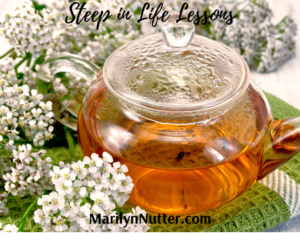January is Hot Tea Month: Steeping in Life Lessons
In celebration of National Hot Tea Month, brew a cup of tea, and let’s look together at lessons tea offers for hopeful living.
 According to legend, in 2737 BC, as Chinese emperor Shen-Nung waited for water to boil, tea leaves from a nearby bush inadvertently fell into the pot. Whether he was curious, thirsty, or a risk-taker, the emperor drank the aromatic brew. He found it delicious, and the beverage, hot tea, was born. Tea became popular in Chinese and Asian culture, but it wasn’t until the 1600s that tea was exported to Europe. Despite being a luxury beverage, its popularity grew.
According to legend, in 2737 BC, as Chinese emperor Shen-Nung waited for water to boil, tea leaves from a nearby bush inadvertently fell into the pot. Whether he was curious, thirsty, or a risk-taker, the emperor drank the aromatic brew. He found it delicious, and the beverage, hot tea, was born. Tea became popular in Chinese and Asian culture, but it wasn’t until the 1600s that tea was exported to Europe. Despite being a luxury beverage, its popularity grew.
Move forward to the mid-1800s when the customary evening meal in England took place around 8 or 9 pm. History tells us that Anna, Duchess of Bedford, complained of a “sinking feeling” mid-afternoon and asked servants to bring her tea and a light snack. It satisfied her hunger, and this became her routine. Tea for one is no fun, so she began inviting friends to join her, adding sandwiches, scones, and pastries. The social event, “Afternoon Tea”, evolved into a “tea-lightful” practice.
“On a given day of the week, the hostess would remain home to receive visitors and serve tea, sandwiches and cakes. Since there was usually at least one person holding an ‘At Home’ on any given day, women would have an opportunity to establish close social ties by seeing each other frequently at different houses throughout the week.”
In an experience similar to the Chinese emperor who stumbled upon a new beverage, Englishman Richard Belchynden creatively invented iced tea. On a hot day at the 1904 St. Louis World’s Fair, steaming tea was not selling, so perhaps out of desperation to not lose money, he poured it over ice and iced tea eventually became the beverage of choice in the South.
Three examples from tea’s long and rich history, show us that the emperor experienced a serendipity, Belchynden used creativity, and Anna of Bedford responded to reality.
How can we relate?
Today, especially with social distancing, we’re not sitting outdoors while someone boils water for us, pleasantly surprised by an extraordinary new beverage. But can our perspective be one of looking for serendipities? How can we find pleasantries in our ordinary and challenging days despite discouraging news broadcasts and personal disappointments? Listening to children’s laughter, reading an engaging novel, or watching an old movie? We are not merchants at a world event and need a burst of creativity, but what about finding creative ways to reach out to people in our neighborhood? Could we place cheery notes on front doors or wrapped treats on a neighbor’s porch as a gesture of kindness and care?
With COVID-19, social distancing is a reality. Some may be reluctant to gather around a tea table and pass treats on a tiered tray, (though wouldn’t a tea party would be wonderful?) but we can gather and have tea and conversation over zoom or a brown bag lunch on a spacious deck, with social distance? What about staying connected by calling or texting someone you waved to a church? Can you share the title of a good book to read, a Bible verse to encourage, or an internet link to inspiration or humor?
Living in unsettled and unpredictable times has overstayed its welcome, so let’s see how we can apply tea lessons to hopeful living. How can you offer encouragement by creatively providing serendipities for the reality of someone’s day? Share your ideas in the comments and perhaps someone wants to adopt yours.
I wrote Tea Lovers’ Devotions to Go several years ago, and applied Biblical lessons to the world of tea. The book is available on the book page on this site and on kindle at Amazon.
As my thank you for reading today, click here for a copy of one of the devotions from my book.. And one more invitation. If you want to read more about tea from my blog, click here for these past posts.


The Conversation
Great thoughts, as always, Ms. Marilyn. Of course, I have to offer up a “Thank Y’all” to Richard Belchynden. 🙂 God’s blessings ma’am.
Yes, JD, I remember my days in Texas when I was offered what seemed like a gallon of iced tea as my serving. I still have a photo showing my surprise. Weather dictated it for sure! Marilyn
What a delightful post, Marilyn. The history was fascinating, and the hope you highlighted is a much-needed blessing in these times. Your tips will. be fun to try!
I know it’s a typo here Jeannie Waters :)–thanks for your comments. Marilyn
But who is Earl Grey?
Warren, thank you for asking. Earl Grey tea is named after Charles, the 2nd Earl Grey and British Prime Minister from 1830 to 1834. It is a black tea with the addition of oil of bergamot. There is also a Lady Grey tea and it contains additional lemon peel and orange peel. There are four types of tea–black, green, oolong, and white, depending on their processing time and all come from the camilla sinensis bush. Herbal teas aren’t teas from that plant but are a “tea” of herbs, spices, fruits, etc. Hope you will enjoy a cuppa sometime this month. Marilyn
Thank you, Marilyn, for the tea lesson. Some I knew, but learned much, too! Have loved tea parties for years, and miss them so much. Looking forward to better tea days!
Thank you for your caring heart and always sharing.
Thanks Debby for joining our conversation today. I look forward to tea parties again soon. They take time to enjoy and that is what sets them apart from a rushed lunch. Hope to have one again soon. Marilyn
Well I had no idea. This was fascinating, and the analogy fits so well with today. I feel like social distancing has sort of made me despondent to creative ideas of socializing. But this was a great encouragement to make a renewed effort.. Thanks!
I think one of the special characteristics of tea is that it takes time-time to steep and time to sip with friends. It’s one of the beverages that we can’t rush and when sipped with a friend enriches both. Thanks for stopping by. Mairlyn
I enjoy both iced tea (southern girl that I am) and hot tea. Thank you for sharing the history behind tea and for inspiring us to look for the bright spots during our isolation. We all need encouragement and your message is a gift of optimism. Thank you!
You’re welcome Katherine. I’m hoping our isolation will become a thing of the past soon. Meanwhile, even tea over zoom can encourage us. Marilyn
I love iced tea and hot tea in the winter. My church ladies group has a tea party every year (I guess we won’t now with covid) and it was so much fun. I won’t look at tea the same way again, Marilyn!
When I lived in PA I was part of a tea group of eight who met monthly. I had always associated tea as a mild beverage to drink when I was sick! Even though our tea parties were elaborate at times, we met for hours and it was always about friendship and the experience, not the menu and fancy table. That is what got me to see tea in a new way. I miss it too. Hope to get back to it once Covid leaves. Marilyn
I loved hearing this history about tea, Marilyn! And it was great how you tied that into creative ideas for getting together to enjoy other’s company and to bless others even in this difficult time.